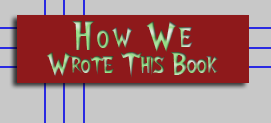


How We Wrote this Book
From the start, we knew that our book was going to be a guidebook. Guidebooks present different challenges then a plain, ordinary book, but doing a guidebook is a lot more fun, and doing a guidebook about ghosts can be quite an experience. To do a guidebook right, you really should go to the spot to which you’re trying to guide your readers. Thus we were forced to go out into the field to make sure our readers could find the spot we reported upon. As we found out, there’s nothing more frustrating than a guidebook with bum directions.
But before we could take the field, we had a lot of reading to do. So our first six months or so were spent culling our own extensive collections on the paranormal then in various libraries. We read ghost books, local histories, newspapers, folklore magazines and any other document that looked like it might be useful. Even when the fieldwork started, our library research continued.
Our labors proved fruitful because we found tons of stories for
This removed a lot of stories from our consideration but we still needed to weed out some more. We decided not to include ghosts that appeared only to one person or only one time because these were generally of limited duration and generally are only significant to those personally involved with the spirit. So one night your Great Uncle Zeb appeared to and told you to look under the loose stone in the fireplace to find his real will, you won’t find it here. We also shied away from ghosts haunting private residences because we were sure most home owners would not want hoards of would be spook hunters banging on the door at all hours or stomping through the flower beds.
Out final selection criterion was quite simple. If, when we got to the field, we could find the location of the story, then it was in. If we couldn’t, we dropped it and it was on to the next tale.
Any research, even that about the quasi-chaotic paranormal, requires discipline so for our fieldwork, we divided the state up into specific areas and surveyed them one by one. If there were enough stories, we would go back as many times as necessary to complete the work. Although it was not our intention, in the course of our fieldwork we managed to debunk a couple of stories and thus we didn’t include them. We also couldn’t find a lot of locations, but quite often in the course of looking, local people would put us on the trail of new stories, often much more interesting than the original ones.
Our field investigations took us two or so years of worth of long, summer, spring and fall weekends (we didn’t go out in the winter because many of the places we needed to see were closed and because the weather in the mountains could be treacherous. Besides, we needed time to write.) In the process we traveled thousands of miles through
When you read the guide you’ll find that we violated every one of our rules at least once. In some instances such as the Zona Shue case, the stories were too well known and historically important and to exclude them would be inexcusable. And what would a book about
Disclaimers:
Authenticity: We do not vouch for the authenticity of any ghost we write about. If we conducted a thorough para-psychological investigation of each site we would finish about the autumn of 2020. Our book is a survey and not an in-depth look at every tale, although we tried to include any insights we might have. We did try to be faithful to our sources and accurately report what they said.
Directions: We can honestly say that we have been in or as near as you could get to every place we’ve written about. If you follow our directions you should be able to find each place we’ve written about. Of course, this assumes that there haven’t been any radical changes in the landscape. We aren’t responsible for any floods, or landslides, strip mines or fires that occurred after we visited a site. In fact, if you find out that a site we’ve written about has been destroyed or changed hands or that the directions are no good because of some natural disaster, E-mail us and let us know.